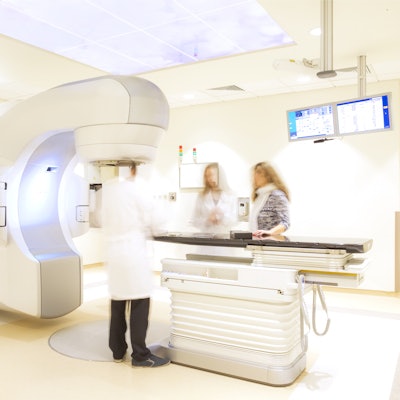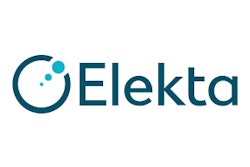
Radiation therapy procedure volume has remained relatively stable throughout 2020, bucking a trend seen in diagnostic radiology, in which the COVID-19 pandemic has led to major drops in imaging exam volume. That's according to a new report on radiation oncology by market research firm IMV Medical Information Division.
 Lorna Young of IMV Medical Information Division.
Lorna Young of IMV Medical Information Division.For 2020, an estimated 1,062,600 cancer patients will be treated with radiation therapy in the U.S., according to IMV's newly published 2020 Radiation Therapy Market Summary Report. Since 2006, the use of radiation therapy to treat cancer patients has been relatively stable, with the estimated number of patient cases increasing at an average annual rate of 1%.
While radiation therapy is a relatively stable market, it appears that the number of treatment visits per patient has declined since 2010, from a high of 22.5 visits per patient to 15.7 in 2020. This may signify that the number of fractions (the series of treatment sessions that make up a patient's course of treatment) has declined over time. With improvements in technology and clinical protocols, patients are not required to have as many sessions to treat their cancer using radiation therapy.
IMV's 2020 Radiation Therapy Market Summary Report is based on interviews with respondents from over 430 radiation therapy departments/facilities who participated in IMV's nationwide survey in February-August 2020. The results are projected to the universe of 2,280 hospitals and nonhospitals that perform radiation therapy in the U.S.
Based on the responses of the survey participants, the number of patient cases treated by the sites in 2020 may have experienced ups and downs this year due to the COVID-19 pandemic, but the net impact on patient volume by the end of the year may be relatively minimal.
Those who participated in the study, conducted in July-August 2020, were asked whether their department has been fully operational or not due to the COVID-19 pandemic. Two-thirds indicated they remained fully operational, while one-third said they have remained open, with some reduced capacity. Some commented that the net impact is being made up as the year has progressed:
- "We started telemed on certain follow-up patients. That's the only thing that differed because of COVID."
- "The only alteration was phone follow-up. Patient volume stayed normal."
- "Our census went down a little bit, but now we're back to normal."
- "The hospital reduced some of the elective surgeries that are usually performed here. However, the [radiation oncology] department was not affected."
- "We pushed some follow-up patients to a later date who were not urgent. However, our treatment and new patients were still being seen on schedule."
- "For six weeks we put off everything that wasn't emergent. We are back now and busier than ever (due to the backlog)."
However, it is likely that the COVID-19 pandemic has impacted the 2020 capital budgets for radiation therapy equipment, with investments being shifted to 2021-2022. A comparison of the 2020 capital budgets planned a year ago in IMV’s 2019 survey compared to this year’s 2020 survey indicates the following changes:
| Impact of COVID-19 on 2020 radiation oncology capital equipment budgets | ||
| Impact on 2020 budgets | 2019 survey | 2020 survey |
| Percent of sites planning zero dollars for 2020 capital purchases | 32% | 39% |
| Percent of sites planning 2020 capital budgets of $1 million or more | 26% | 18% |
The good news is that going forward, a higher 25% of the sites are planning to have capital budgets of $1 million or more in 2021 and 2022, compared with the current 18% of 2020 budgets.
IMV's report provides a department-wide view of the key radiation therapy technologies used in treating cancer patients, including external-beam radiation therapy equipment, image-guided radiotherapy (IGRT), brachytherapy equipment, treatment planning systems, simulators (x-ray, CT, PET, and MRI), and oncology information systems.
External-beam radiation therapy equipment
The center stage for radiation therapy treatments takes place with external-beam therapy technology, which includes traditional linear accelerators plus Gamma Knife, CyberKnife, and TomoTherapy configurations, as well as the newest technology platform, proton therapy.
The installed base of all types of external-beam therapy systems is estimated to be 3,770 units in 2,280 sites in the U.S. Key manufacturers include Accuray (which owns TomoTherapy), Elekta (including GammaKnife systems), and Varian Medical Systems, which has been the dominant manufacturer of linear accelerators. Siemens exited the linear accelerator business in 2012, but it is planning to reenter the radiation therapy market, having announced plans this August to acquire Varian, with the deal expected to close in the first half of 2021.
Treatment planning
For treatment planning, virtually all the radiation therapy sites reported using CT technology in some portion of their treatment plans. However, due to the ability of PET imaging to identify the extent and change in the metabolism of tumor cells, the use of PET images in treatment planning has more than doubled over the past decade to about 30% of treatment plans.
In addition, with the ability of MRI technology to identify tumors without the use of ionizing radiation, the use of MR images has also doubled since 2010. The key manufacturers being considered for future treatment planning system purchases include Accuray, Brainlab, Elekta, Philips, RaySearch, Varian, and ViewRay.
Simulators
Prior to a patient being treated using radiation therapy, their treatment plans are simulated using simulator hardware and virtual simulation software applications. Regarding the simulation hardware, CT simulators have substituted for x-ray technology, which used to be dominated by Varian and Elekta (including Nucletron). The traditional CT scanner providers are now the key providers of simulator hardware, including Canon Medical Systems, GE Healthcare, Philips Healthcare, and Siemens Healthineers. Meanwhile, PET/CT simulators are increasingly being used, growing from 1% of the simulator installed base to over 10%.
Image-guided radiotherapy
The real-time use of imaging technology to guide radiation therapy treatments has increased dramatically over the past 15 years, rising from 15% of the sites using image-guided radiation therapy (IGRT) technology as of 2004 to over 90% of the radiation therapy sites. Of the current IGRT installed base, the top three types of image guidance systems used are CT or conebeam CT, electronic portal imaging devices, x-ray, and surface-guided radiation therapy (SGRT). Going forward, CT technology is the most preferred by those planning IGRT purchases. Key IGRT manufacturers include Accuray, Brainlab, Elekta, Varian, Vision RT, and ViewRay.
Record and verify and oncology information systems
Virtually all the radiation therapy sites have some type of record and verify or oncology information system installed. The top data types available on such systems are scheduling capabilities, images, electronic medical records (EMR), and billing records. Key information system manufacturers used by the radiation therapy sites include Accuray, Elekta, Epic, and Varian.
Lorna Young is senior director of imaging insights at IMV Medical Information Division, part of Science and Medicine Group.
IMV's 2020 Radiation Therapy Market Summary Report provides a department-wide view of the key radiation therapy technologies used in treating cancer patients, including external beam therapy equipment, image-guided radiotherapy (IGRT), brachytherapy equipment, treatment planning systems, simulators (x-ray, CT, PET, and MRI), and oncology information systems. This report monitors trends over the past decade in the top cancer types treated with radiation, patient volume, installed equipment, market share, and technology adoption rates, as well as future plans for acquiring and using such technologies. Over 25 manufacturers providing hardware and software solutions for radiation therapy are covered in this report.
The data source for this report is IMV's 2020/21 Radiation Therapy Census Database, which provides comprehensive profiles of hospital and nonhospital sites performing radiation therapy in the United States. This database can be separately licensed by qualified subscribers.
For information about purchasing IMV's 2020 Radiation Therapy Market Summary Report or IMV's 2020/21 Radiation Therapy Census Database, visit the corporate website at www.imvinfo.com or call 773-778-3080 to speak with a representative.
Disclosure: IMV Medical Information Division is a sister company of AuntMinnie.com.



















